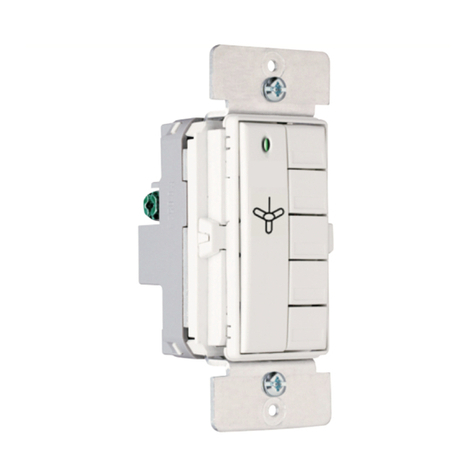LIMITED FIVE YEAR WARRANTY
Pass & Seymour will remedy any defect in workmanship or material in Pass & Seymour products which may
develop under proper and normal use within five years from date of purchase by a consumer: (1) by repair
or replacement, or, at Pass & Seymourʼs option, (2) by return of an amount equal to consumerʼs purchase
price. Such remedy is IN LIEU OF ANY AND ALL EXPRESSED OR IMPLIED WARRANTIES OF
MERCHANTABILITY OR FITNESS FOR A PARTICULAR PURPOSE. Such remedy by Pass & Seymour
does not include or cover cost of labor for removal or reinstallation of the product. ALL OTHER FURTHER
ELEMENTS OF DAMAGE (INCIDENTAL OR CONSEQUENTIAL DAMAGES) FOR BREACH OF ANY
AND ALL EXPRESSED OR IMPLIED WARRANTIES INCLUDING WARRANTIES OF MERCHANTABILITY
OR FITNESS FOR A PARTICULAR PURPOSE ARE EXCLUDED HEREBY. (Some states do not allow
disclaimers or exclusion or limitation of incidental or consequential damages, so the above disclaimer and
limitation or exclusion may not apply to you.) ANY IMPLIED WARRANTIES INCLUDING WHERE
REQUIRED WARRANTIES OF MERCHANTABILITY OR FITNESS FOR A PARTICULAR PURPOSE SHALL
BE LIMITED TO THE FIVE YEAR PERIOD SET FORTH ABOVE. (Some states do not allow limitations on
how long an implied warranty lasts, so the above limitation may not apply to you.) To ensure safety, all repairs
to Pass & Seymour products must be made by Pass & Seymour, or under its specific direction. Procedure
to obtain performance of any warranty obligation is as follows: (1) Contact Pass & Seymour, Syracuse, New
York 13221, for instructions concerning return or repair; (2) return the product to Pass & Seymour, postage
paid, with your name and address and a written description of the installation or use of the Pass & Seymour
product, and the observed defects or failure to operate, or other claimed basis for dissatisfaction. This
warranty gives you specific legal rights and you may also have other rights which vary from state to state.
FCC NOTICE
This equipment has been tested and found to comply with the limits for a Class
B digital device, pursuant to part 15 of the FCC Rules. These limits are
designed to provide reasonable protection against harmful interference in a
residential installation. This equipment generates, uses and can radiate radio
frequency energy and, if not installed and used in accordance with the
instructions, may cause harmful interference to radio communications. However,
there is no guarantee that interference will not occur in a particular installation. If
this equipment does cause harmful interference to radio or television reception,
which can be determined by turning the equipment off and on, the user is
encouraged to try to correct the interference by one or more of the following
measures:
• Reorient or relocate the receiving antenna.
• Increase the separation between the equipment and receiver.
• Connect the equipment into an outlet on a circuit different from that to which
the receiver is connected.
• Consult the dealer or an experienced radio/TV technician for help.
Caution: Any changes or modifications to this device not explicitly approved by
Pass & Seymour/Legrand could void your authority to operate this equipment.
CLEANING
Clean using a cloth dampened only with water and a little mild detergent. Use of
solvents or hydrocarbon-based cleaners may cause permanent damage.
POWER FAIL MEMORY
After a power failure, all LightSense™ devices automatically return to the state
they were in immediately prior to loss of power. All house binding and scene
control information is preserved.
P.O. Box 4822 • Syracuse, NY • 13221-4822
Technical Support: 800.223.4185
www.passandseymour.com
340746 Rev. C




























